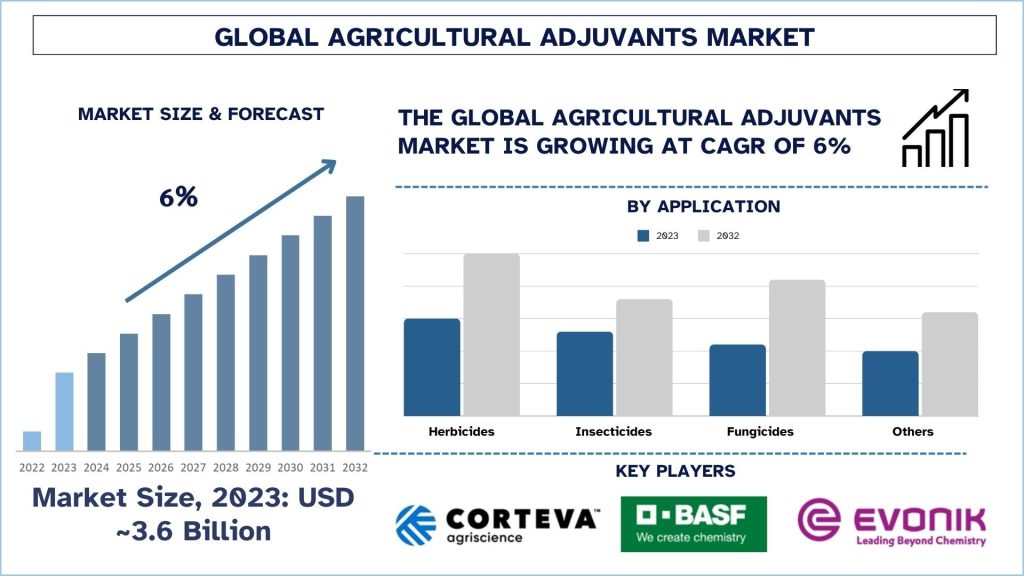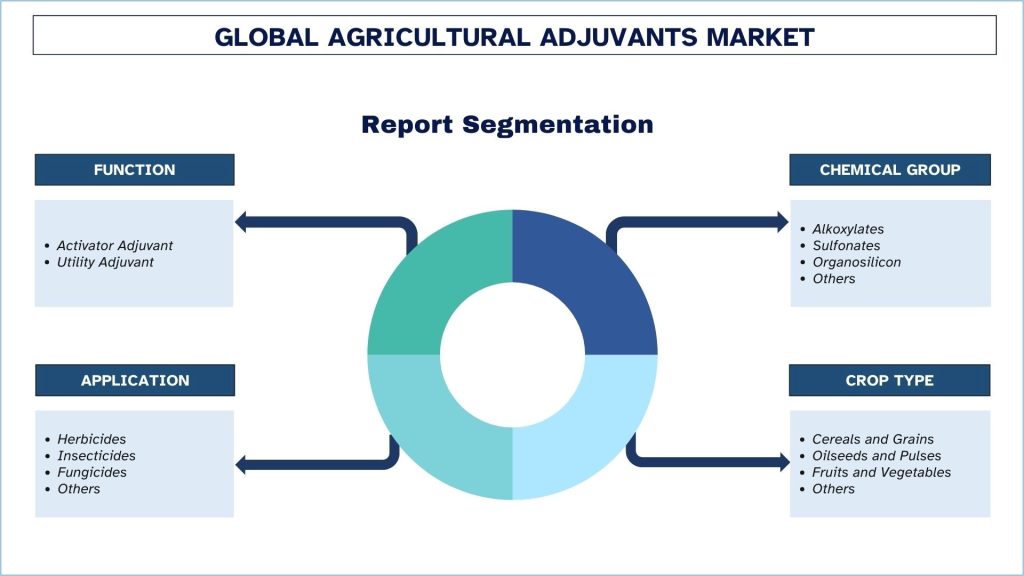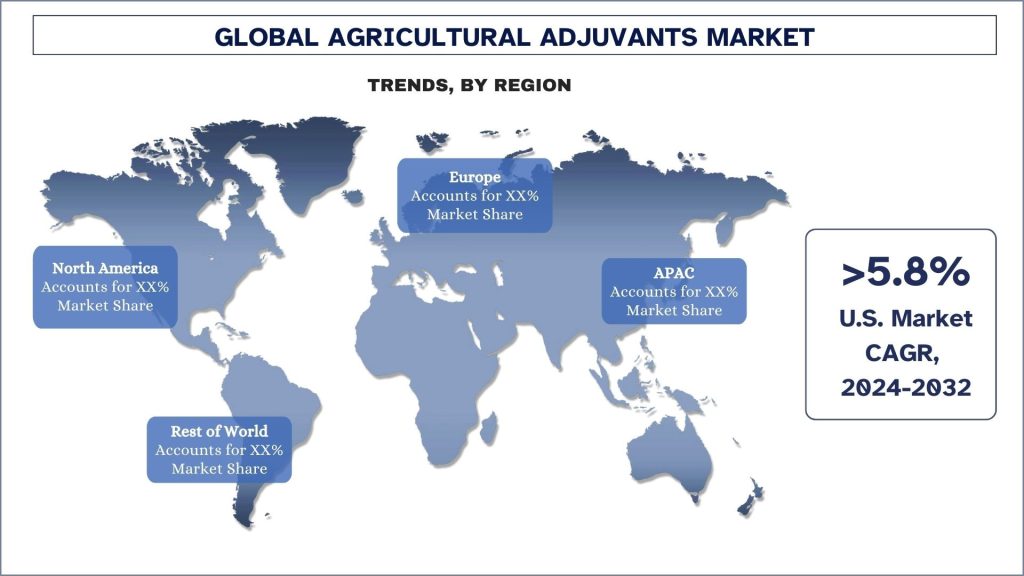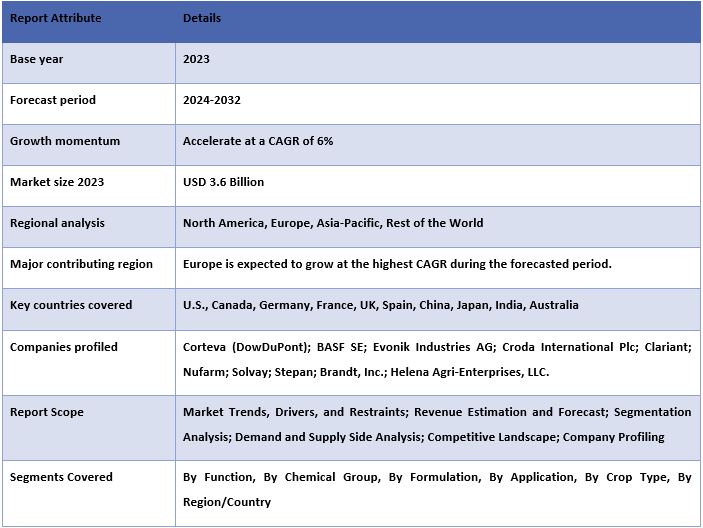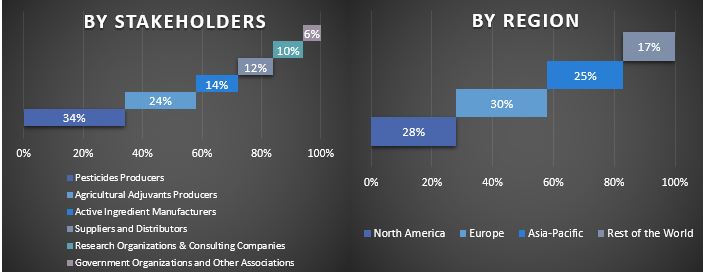Agricultural Adjuvants Market: Current Analysis and Forecast (2024-2032)
$3999 – $6999
Emphasis on Function {Activator Adjuvants [Surfactant (Non-Ionic, Ionic, and Others) and Oil-based (Vegetable Oil and Petroleum Oil)], Utility Adjuvants (Compatibility Agents, Buffers/Acidifiers, Anti-Foaming Agents, Water Conditioners, Drift Control Agents, and Others)}; Chemical Group (Alkoxylates, Sulfonates, Organosilicon, and Others); Formulation (Built-In and Tank Mix); Application (Herbicides, Insecticides, and Others); Crop Type (Cereals And Grains, Oilseeds And Pulses, Fruits And Vegetables, and Others); and Region/Country
| Published: | Jan-2022 |
|---|---|
| Pages: | 342 |
| Table: | 52 |
| Figure: | 136 |
| Report ID: | UMAG21641 |
| Geography: |

Report Description
Agricultural Adjuvants Market Size & Forecast
The Agricultural Adjuvants market was valued at approximately USD 3.6 Billion in 2023 and is expected to grow at a substantial CAGR of around 6% during the forecast period (2024-2032) owing to the rising adoption of renewable energy.
Agricultural Adjuvants Market Analysis
Agriculture Adjuvants are chemicals known as additives that are mixed with herbicides, pesticides, and fungicides to improve their characteristics. These are extension agents of the chemicals enhancing the spreadability, plant adherence, and absorption to maximize the protection of crops. They also assist in decreasing the amount of chemical that needs to be applied since they can make the chemical spread to a large area reducing the rate at which resistance is created by weather factors such as rain and wind making them important tools in modern farming.
To experience growth in this sector, companies are increasingly employing various measures such as creating environment-friendly, biobased adjuvants to meet the global demands for environmentally sustainable methods of farming. As well as, investing in enhanced formulation technologies to enhance adjuvant efficacy and uniformity and diversifying their regional footprint in areas where agribusiness productivity is important. These are academically complemented by partnerships and collaborations with agrochemical firms to enhance product development and market expansion.
Agricultural Adjuvants Market Trends
This section discusses the key market trends influencing the various segments of the agricultural adjuvants market as identified by our research experts.
Biobased and Eco-Friendly Adjuvants Transform Agricultural Adjuvants Industry
Increasingly environmentally friendly agriculture adjuvants such as biobased and eco-friendly ones are particularly instrumental in defining the market trends to target the growing market for sustainable agriculture solutions. These are products obtained from natural sources meaning that their use lowers the negative effects of chemicals hence appealing to environmentally conscious farmers. Concerning the nature and source of adjuvants, the governments and regulatory bodies are encouraging the use of environmentally friendly agricultural inputs hence the promotion of these adjuvants. This reduces their impact on soil and water pollution and is in keeping with sustainable development plans on the planet. Besides, biobased adjuvants enhance the efficacy of agrochemicals, so farmers obtain more efficiency with less application, which also increases the adjuvants’ popularity.
North America leads the market.
North America dominates the global agriculture adjuvants market mainly due to increased farming technology and utilization of agrochemicals. Large-scale farming operations have emerged to service the region, requiring efficient adjuvant application for improving crop yield, and protection against pests. Higher-level technologies like precision farming add to the demand for targeted adjuvants that enhance chemical usage. Growing demand for organic agricultural solutions arising from regulatory support increases the uptake of environment-friendly adjuvants. Factors such as the availability of raw materials, many major agrochemical companies, and progressive R&D into improved formulations also bolster the market. Also, increasing concerns about herbicide-resistant weeds compel farmers to use adjuvants to enhance weed management.
Agricultural Adjuvants Industry Overview
The Agricultural Adjuvants market is competitive, with several global and international players. The key players are adopting different growth strategies to enhance their market presence, such as partnerships, agreements, collaborations, new product launches, geographical expansions, and mergers and acquisitions. Some of the major players operating in the market are Corteva (DowDuPont); BASF SE; Evonik Industries AG; Croda International Plc; Clariant; Nufarm; Solvay; Stepan; Brandt, Inc.; Helena Agri-Enterprises, LLC.
Agricultural Adjuvants Market News
In January 2023, Nouryon announced that it had completed the acquisition of ADOB, a leading supplier of chelated micronutrients, foliars, and other specialty agricultural solutions headquartered in Poland.
On March 19, 2024 – Corteva, Inc. (NYSE: CTVA) announced the launch of Corteva Catalyst, a new investment and partnership platform focused on accessing and bringing to market agricultural innovations that advance the company’s R&D priorities and drive value creation.
Agricultural Adjuvants Market Report Coverage
Reasons to buy this report:
- The study includes market sizing and forecasting analysis validated by authenticated key industry experts.
- The report presents a quick review of overall industry performance at one glance.
- The report covers an in-depth analysis of prominent industry peers with a primary focus on key business financials, product portfolios, expansion strategies, and recent developments.
- Detailed examination of drivers, restraints, key trends, and opportunities prevailing in the industry.
- The study comprehensively covers the market across different segments.
- Deep dive regional level analysis of the industry.
Customization Options:
The global Agricultural Adjuvants market can be customized further as per the requirement or any other market segment. Besides this, UMI understands that you may have your own business needs, hence feel free to connect with us to get a report that completely suits your requirements.
Frequently Asked Questions (FAQ)
Q1: What is the Agricultural Adjuvants market's current size and growth potential?
Ans: The Agricultural Adjuvants market was valued at USD 3.6 Billion in 2023 and is expected to grow at a CAGR of 6% during the forecast period (2024-2032).
Q2: What are the driving factors for the growth of the Agricultural Adjuvants market?
Ans: The rising demand for higher crop yields, rising advancements in agrochemicals, growth of precision farming, and rising adoption of sustainable farming practices driving the agricultural adjuvants market.
Q3: Which segment has the largest share of the Agricultural Adjuvants market by application?
Ans: The herbicides segment has the largest share of the Agricultural Adjuvants market by application.
Q4: What are the major trends in the Agricultural Adjuvants market?
Ans: The growing interest in biobased adjuvants and the integration of adjuvants with precision spraying technology are the major trends in the Agricultural Adjuvants market.
Q5: Which region will dominate the Agricultural Adjuvants market?
Ans: North America dominate the market in 2023.

You can also purchase parts of this report. Do you want to check out a section wise
price list?
Research Methodology
Research Methodology for the Agricultural Adjuvants Market Analysis (2022-2032)
Analyzing the historical market, estimating the current market, and forecasting the future market of the global Agricultural Adjuvants market were the three major steps undertaken to create and analyze the adoption of Agricultural Adjuvants in major regions globally. Exhaustive secondary research was conducted to collect the historical market numbers and estimate the current market size. Secondly, to validate these insights, numerous findings and assumptions were taken into consideration. Moreover, exhaustive primary interviews were also conducted, with industry experts across the value chain of the global Agricultural Adjuvants market. Post assumption and validation of market numbers through primary interviews, we employed a top-down/bottom-up approach to forecasting the complete market size. Thereafter, market breakdown and data triangulation methods were adopted to estimate and analyze the market size of segments and sub-segments of the industry. Detailed methodology is explained below:
Analysis of Historical Market Size
Step 1: In-Depth Study of Secondary Sources:
A detailed secondary study was conducted to obtain the historical market size of the Agricultural Adjuvants market through company internal sources such as annual reports & financial statements, performance presentations, press releases, etc., and external sources including journals, news & articles, government publications, competitor publications, sector reports, third-party database, and other credible publications.
Step 2: Market Segmentation:
After obtaining the historical market size of the Agricultural Adjuvants market, we conducted a detailed secondary analysis to gather historical market insights and share for different segments & sub-segments for major regions. Major segments are included in the report as function, chemical group, formulation, application, and crop type, and regions. Further country-level analyses were conducted to evaluate the overall adoption of testing models in that region.
Step 3: Factor Analysis:
After acquiring the historical market size of different segments and sub-segments, we conducted a detailed factor analysis to estimate the current market size of the Agricultural Adjuvants market. Further, we conducted factor analysis using dependent and independent variables such as function, chemical group, formulation, application, crop type, and regions of the Agricultural Adjuvants market. A thorough analysis was conducted for demand and supply-side scenarios considering top partnerships, mergers and acquisitions, business expansion, and product launches in the Agricultural Adjuvants market sector across the globe.
Current Market Size Estimate & Forecast
Current Market Sizing: Based on actionable insights from the above 3 steps, we arrived at the current market size, key players in the global Agricultural Adjuvants market, and market shares of the segments. All the required percentage shares split and market breakdowns were determined using the above-mentioned secondary approach and were verified through primary interviews.
Estimation & Forecasting: For market estimation and forecast, weights were assigned to different factors including drivers & trends, restraints, and opportunities available for the stakeholders. After analyzing these factors, relevant forecasting techniques i.e., the top-down/bottom-up approach were applied to arrive at the market forecast for 2032 for different segments and sub-segments across the major markets globally. The research methodology adopted to estimate the market size encompasses:
- The industry’s market size, in terms of revenue (USD) and the adoption rate of the Agricultural Adjuvants market across the major markets domestically
- All percentage shares, splits, and breakdowns of market segments and sub-segments
- Key players in the global Agricultural Adjuvants market in terms of products offered. Also, the growth strategies adopted by these players to compete in the fast-growing market
Market Size and Share Validation
Primary Research: In-depth interviews were conducted with the Key Opinion Leaders (KOLs) including Top Level Executives (CXO/VPs, Sales Head, Marketing Head, Operational Head, Regional Head, Country Head, etc.) across major regions. Primary research findings were then summarized, and statistical analysis was performed to prove the stated hypothesis. Inputs from primary research were consolidated with secondary findings, hence turning information into actionable insights.
Split of Primary Participants in Different Regions
Market Engineering
The data triangulation technique was employed to complete the overall market estimation and to arrive at precise statistical numbers for each segment and sub-segment of the global agricultural adjuvants market. Data was split into several segments and sub-segments after studying various parameters and trends in the function, chemical group, formulation, application, crop type, and regions of the global Agricultural Adjuvants market.
The main objective of the Global Agricultural Adjuvants Market Study
The current & future market trends of the global Agricultural Adjuvants market were pinpointed in the study. Investors can gain strategic insights to base their discretion for investments on the qualitative and quantitative analysis performed in the study. Current and future market trends determined the overall attractiveness of the market at a regional level, providing a platform for the industrial participant to exploit the untapped market to benefit from a first-mover advantage. Other quantitative goals of the studies include:
- Analyze the current and forecast market size of the Agricultural Adjuvants market in terms of value (USD). Also, analyze the current and forecast market size of different segments and sub-segments.
- Segments in the study include areas of the function, chemical group, formulation, application, crop type, and regions.
- Define and analyze the regulatory framework for the Agricultural Adjuvants
- Analyze the value chain involved with the presence of various intermediaries, along with analyzing customer and competitor behaviors of the industry.
- Analyze the current and forecast market size of the Agricultural Adjuvants market for the major region.
- Major countries of regions studied in the report include Asia Pacific, Europe, North America, and the Rest of the World
- Company profiles of the Agricultural Adjuvants market and the growth strategies adopted by the market players to sustain the fast-growing market.
- Deep dive regional level analysis of the industry


